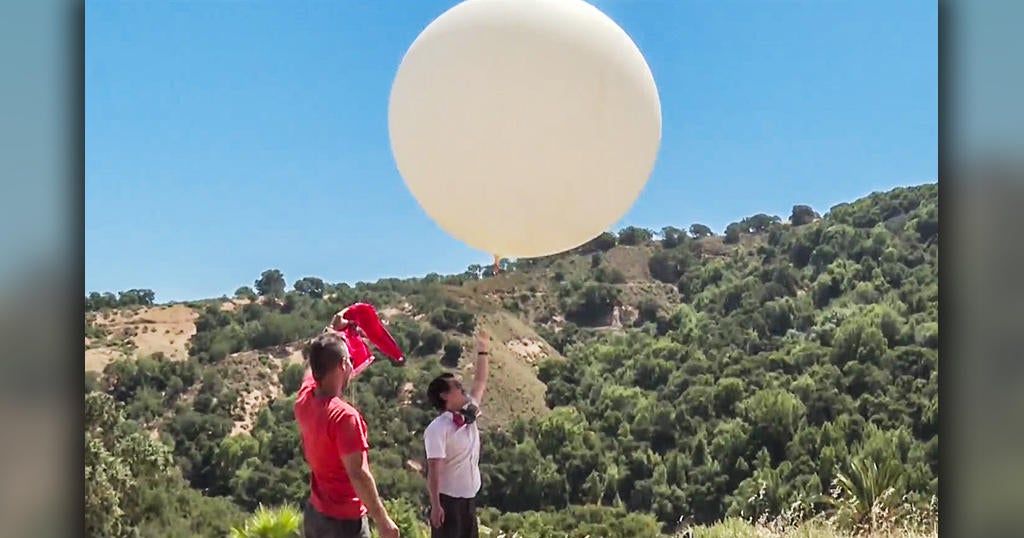High in the hills near Silicon Valley, a controversial weather balloon mission will soon take off.
In a trailer on a scorching hot day, Luke Iseman and Andrew Song are busy preparing instrumentation to be attached to the balloon. Iseman and Song are the co-founders of a startup called Make Sunsets.
Song then went outside, unfolded a balloon and began filling it with two gas cylinders.
“Go ahead and start slow,” Iseman instructed.
Sulfur dioxide and helium are pumped into the expanding latex balloon.
Once the balloon is properly filled with the right mixture at high altitude, Song releases it. The helium will carry it more than 12 miles above the Earth’s surface into the stratosphere. Once there, the balloon bursts, releasing the sulfur dioxide.
The idea: The gas turns into an aerosol, which reflects sunlight back into space, cooling the planet.
“That gas reacts with other things and forms clouds that reflect a little bit of sunlight back into space before it can warm the Earth,” Iseman said.
The strategy is a form of solar geoengineering called Stratospheric Aerosol Injection, or SAI for short. It attempts to temporarily cool the planet while human activities continue to warm it, by burning fossil fuels.
“Much of the world is racing ahead, drilling baby drills. We also need innovation for solutions, because the problem is getting worse,” Iseman explains.
Greenhouse gas emissions are not being reduced fast enough and current efforts may not be enough to delay or limit the worst effects of global warming.
“Even if we could magically stop using fossil fuels tomorrow and somehow have some other magical energy to replace it, this warming will still be built in,” Song explains.
The method used by these two men could be a way to buy time as scientists try to find better solutions to reduce rising global temperatures.
Since 2022, Iseman and Song have launched more than 80 balloons. They contact the FAA for each launch and file paperwork with NOAA once a year.
The concept behind the method is based on the planet-cooling effects of volcanic eruptions. A good example is the massive eruption of Mount Pinatubo in the Philippines in 1991.
15 million tons of sulfur dioxide aerosols were sprayed into the stratosphere, causing global temperatures to drop.
“Pinatubo caused the Earth to cool by about three-tenths of a degree Celsius, or half a degree Fahrenheit, for several years after the eruption,” said Dr. William Collins, associate laboratory director of the Earth and Environmental Sciences Division at Lawrence Berkeley National Laboratory.
Collins is also an expert on aerosols and climate change science.
“We know that these aerosols can cool the climate. And the question people are asking now is can we do that artificially,” the scientist told CBS News Bay Area.
Another open question: what about the risks?
Make Sunsets is not alone in its commitment to solar geoengineering.
There are larger entities around the world that are also looking at using the technology, and that is a concern for other scientists.
“We don’t want to go all out with a deployment right now. We don’t know what’s going to happen,” said Dr. Lisa Dilling, an associate chief scientist at the Environmental Defense Fund.
The non-profit organization funds scientific research into artificial cooling technologies.
The goal: to identify and better understand unknown risks or side effects.
“We’re going to look at how we can compare this to the risks of climate change itself,” Dilling added.
NOAA’s Climate Program Office is actively researching the technology, as are several think tanks around the world, including the Kleinman Center for Energy Policy at the University of Pennsylvania.
As for Iseman and Song, their efforts are not illegal. They also sell cooling credits to companies and individuals to offset their carbon footprint.
The team is eager to share its data with scientists, but does not want to stop the launches.
“We cannot allow concern about impact to be an excuse for inaction. Otherwise, we will end up with even more intense versions of all the problems we already have,” Iseman concluded.




